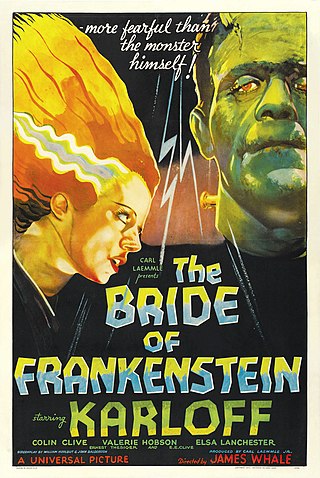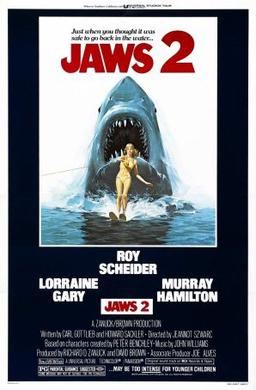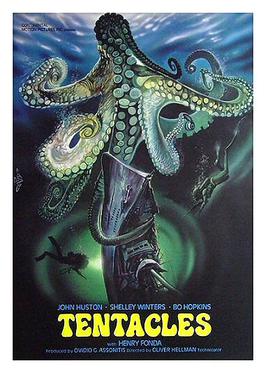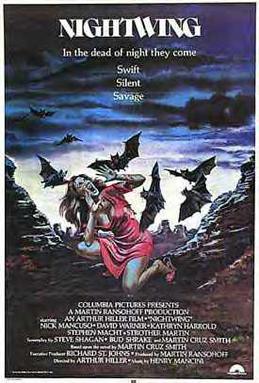
The orca, or killer whale, is a toothed whale that is the largest member of the oceanic dolphin family. It is the only extant species in the genus Orcinus. Orcas are recognizable by their black-and-white patterned body. A cosmopolitan species, orcas are found in diverse marine environments, from Arctic to Antarctic regions to tropical seas.

Bride of Frankenstein is a 1935 American science fiction horror film, and the first sequel to Universal Pictures' 1931 film Frankenstein. As with the first film, Bride of Frankenstein was directed by James Whale starring Boris Karloff as the Monster and Colin Clive as Dr. Frankenstein. The sequel features Elsa Lanchester in the dual role of Mary Shelley and the bride. Colin Clive reprises his role as Henry Frankenstein, and Ernest Thesiger plays the role of Doctor Septimus Pretorius. Oliver Peters Heggie plays the role of the old blind hermit.

Jaws 2 is a 1978 American thriller film directed by Jeannot Szwarc and co-written by Carl Gottlieb. It is the sequel to Steven Spielberg's Jaws (1975), and the second installment in the Jaws franchise. The film stars Roy Scheider as Police Chief Martin Brody, with Lorraine Gary and Murray Hamilton reprising their respective roles as Martin's wife Ellen Brody and mayor Larry Vaughn. It also stars Joseph Mascolo, Jeffrey Kramer, Collin Wilcox, Ann Dusenberry, Mark Gruner, Susan French, Barry Coe, Donna Wilkes, Gary Springer, and Keith Gordon in his first feature film role. The plot concerns Chief Brody suspecting another great white shark is terrorizing the fictional seaside resort of Amity Island, following a series of incidents and disappearances, and his suspicions are eventually proven true.

Agostino "Dino" De Laurentiis was an Italian film producer and businessman who held both Italian and American citizenship. Following a brief acting career in the late 1930s and early 1940s, he moved into film production; alongside Carlo Ponti, he brought Italian cinema to the international scene in the post-World War II period. He produced or co-produced over 500 films, with 38 of his Hollywood films receiving Academy Award nominations. He was also the creator and operator of DDL Foodshow, a chain of Italian specialty foods stores.

King Kong is a 1976 American monster adventure film produced by Dino De Laurentiis and directed by John Guillermin. It is a modernized remake of the 1933 film about a giant ape that is captured and taken to New York City for exhibition. It stars Jeff Bridges, Charles Grodin, and Jessica Lange in her first film role, and features mechanical effects by Carlo Rambaldi and makeup effects by Rick Baker who also played the title character. It is the fifth entry in the King Kong franchise.

Jaws 3-D is a 1983 American horror film directed by Joe Alves and starring Dennis Quaid, Bess Armstrong, Simon MacCorkindale and Louis Gossett Jr. It is the second sequel to Steven Spielberg's Jaws and the third installment in the Jaws franchise. The film follows the Brody children from the previous films to SeaWorld, a Florida marine park with underwater tunnels and lagoons. As the park prepares for opening, a young great white shark infiltrates the park from the sea, seemingly attacking and killing the park's employees. Once the shark is captured, it becomes apparent that a second, much larger shark also entered the park and was the real culprit.
Orca is another name for a killer whale, the world's biggest dolphin species.

Grizzly is a 1976 American horror thriller film directed by William Girdler, about a park ranger's attempts to halt the wild rampage of an 18 ft (5.5 m) tall, 2,000 lb (910 kg) man-eating grizzly bear that terrorizes a National Forest, having developed a taste for human flesh. However, a drunken hunting party complicates matters. It stars Christopher George, Andrew Prine and Richard Jaeckel. Widely considered a Jaws rip-off, Grizzly used many of the same plot devices as its shark predecessor, which had been a huge box office success during the previous year. The giant grizzly bear in the film was portrayed by a Kodiak bear named Teddy, who was 11 ft (3.4 m) tall.

The Shark is Still Working is an American documentary film on the impact and legacy of the 1975 Steven Spielberg blockbuster film Jaws. It features interviews with a range of cast and crew from the film. It is narrated by Roy Scheider and dedicated to Peter Benchley.
Orcas are large, powerful aquatic apex predators. There have been multiple orca attacks on humans in the wild, but such attacks are less common than those by captive orcas. In captivity, there have been several non-fatal and four fatal attacks on humans since the 1970s. Experts are divided as to whether the injuries and deaths were accidental or deliberate attempts to cause harm.

Tentacles is a 1977 horror-thriller film directed by Ovidio G. Assonitis and starring John Huston, Shelley Winters, Bo Hopkins, Cesare Danova, Delia Boccardo and Henry Fonda.

Shark Jaws is a single-player arcade video game by Atari, Inc. under the name of Horror Games, originally released in 1975. An unlicensed tie-in to the movie Jaws, and believed to be the first commercially released movie tie-in, it was created to be a game about sharks eating people. Atari head Nolan Bushnell originally tried to license the Jaws name, but was unable to secure a license from Universal Pictures. Deciding to go ahead with the game anyway, it was retitled Shark JAWS, with the word Shark in tiny print and JAWS in large all caps print to create greater prominence. Bushnell created a second hidden subsidiary corporation, Horror Games—the previous being Kee Games—to help isolate Atari from a possible lawsuit. According to Bushnell, the game was successful enough to sell approximately two thousand units.

Jaws is an American thriller film series that started with a 1975 film that expanded into three sequels, a theme park ride, and other tie-in merchandise, based on a 1974 novel. The main subject of the saga is a great white shark and its attacks on people in specific areas of the United States and The Bahamas. The Brody family is featured in all of the films as the primary antithesis to the shark. The original film was based on a novel written by Peter Benchley, which itself was inspired by the Jersey Shore shark attacks of 1916. Benchley adapted his novel, along with help from Carl Gottlieb and Howard Sackler, into the 1975 film Jaws, which was directed by Steven Spielberg. Although Gottlieb went on to pen two of the three sequels, neither Benchley nor Spielberg returned to the film series in any capacity.

Nightwing is a 1979 American horror film directed by the Canadian filmmaker Arthur Hiller. The screenplay was written by Martin Cruz Smith, Steve Shagan and Bud Shrake, based on the 1977 novel of the same title by Smith. The movie's tagline is "Day belongs to man, but night is theirs!" It was one of many imitators of the 1975 film Jaws. Such movies about animals gone wild were popular in the late 1970s and early 1980s. These included Grizzly (1976), Orca (1977), Tentacles (1977), The Pack (1977), Piranha (1978), Alligator (1980) and Great White (1980).
Orcas, also known as Killer whales, have appeared in several movies and many documentaries.

Namu, the Killer Whale is a 1966 American film about a "killer whale" (orca) being studied by a local marine biologist after the murder of his mate and initially feared by local townspeople.

Cruel Jaws is a 1995 Italian direct-to-video horror film directed by Bruno Mattei under the pseudonym William Snyder. The film stars Richard Dew and David Luther, and was shot in Florida, including at the Theater of the Sea marine theme park in Islamorada.

Deep Blue Sea 3 is a 2020 American science fiction natural horror film, starring Tania Raymonde. Dr. Emma Collins and her team are on Little Happy Island studying the effect of climate change on great white sharks who come to the nearby nursery every year to give birth, their peaceful life is disrupted when a "scientific" team shows up looking for three bull sharks. It is the third and final installment of the Deep Blue Sea film series, and a direct sequel to Deep Blue Sea 2.
Port and Starboard are a pair of adult male orcas notable for preying on great white sharks off the coast of South Africa. The duo are identified as having rare and distinct collapsed dorsal fins and they are named for the nautical terms, as Port's fin collapses left and Starboard's collapses right. Port and Starboard are part of a distinctive "flat-toothed" ecotype present around South Africa.















